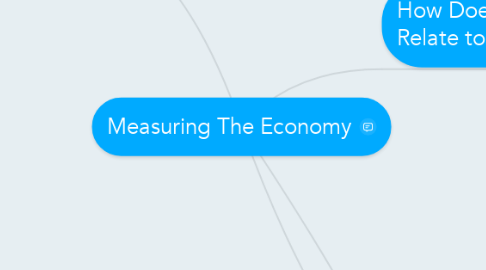Measuring The Economy
by HUNTER HAGER

1. How Do Economists Measure the Size of an Economy?
1.1. Gross Domestic Product or GDP is one way to measure the economy.
1.2. The Equation For GDP is C+I+GNX=GDP
1.3. There are three types of GDP Nominal GDP real GDP and per capita GDP
1.4. Nominal GDP: a measure of a country’s economic output (GDP) valued in current dollars; nominal GDP does not reflect the effects of inflation
1.5. Real GDP: a measure of a country’s economic output (GDP) valued in constant dollars; real GDP reflects the effects of inflation
1.6. Per Capita GDP:a nation’s real GDP divided by its population; a measure of average economic output per person
2. What Does the Unemployment Rate Tell Us About an Economy’s Health?
2.1. The Unemployment rate tells you how many people have an income that can contribute to the Growth of the Economy
2.1.1. There is Four types of unemployment: Structural unemployment. People who choose to change jobs are in transition Seasonal unemployment. In some markets, demand for labor depends on the season and cyclical unemployment. Every economy goes through prosperous times and hard times
2.2. If the unemployment rate is down it is a sign of a Good and healthy economy.
2.3. Cyclical Unemployment: a type of unemployment that results from a period of decline in the business cycle; unemployment caused by a contraction
2.4. Seasonal Unemplyment : a type of unemployment that results when businesses shut down or slow down for part of the year, often because of weather
3. What Does the Inflation Rate Reveal About an Economy’s Health
3.1. The higher the Inflation Rate the more things cost in general meaning there is less usable money in the Economy
3.2. We measure the inflation rate by monitoring the cost of living and comparing it over time the BLS does it
3.3. There are three types of inflation Creeping Inflation happens over time, Hyperinflation is very fast and is bad, and Deflation is when things get cheaper
3.4. Creeping inflation: a gradual, steady rise in the price of goods and services over time.
3.5. Deflation: a fall in the price of goods and services; the opposite of inflation
3.6. This article has meaing to this topic bacaue it helps you understand the topic betterhttp://www.investopedia.com/articles/06/gdpinflation.asp
4. How Does the Business Cycle Relate to Economic Health?
4.1. Depending on the Phase in the cycle depends on if we are booming or crashing or in between it is a large part.
4.2. The Four stages in the business cycle are: Expansion which is the growth stage Peak which is the climax where everything is good Contraction where it condenses down and slows down and Trough where everything sucks and not a lot of money circulating.
4.3. The Picture wont Upload
4.4. Peak: the highest point of an expansion, or period of economic growth; a peak is followed by economic decline
4.5. contraction: a period of general economic decline marked by falling GDP and rising unemployment



